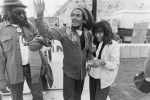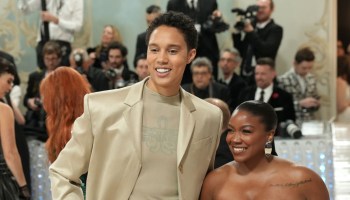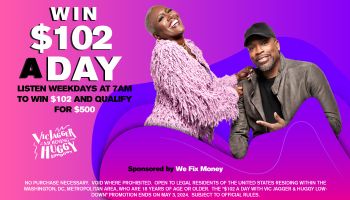VIA WASHINGTON POST:
Aba Kwawu vowed she’d buy only one or two classic pieces for work that would last her for years. So what was she doing recently at the cash register of a Washington boutique, credit card in hand, agonizing over whether to buy a flashy designer purse with faux snake trim?
“I don’t need anything. I don’t need a bag,” Kwawu said, and sighed. She barely looked at the pricey but practical gray sweater coat she was supposed to be buying, already wrapped in an elaborate origami of tissue at her elbow. She only had eyes for the $695 green-and-black handbag next to it that looked so cute when she slung it over her shoulder and twirled in front of the mirror a few minutes earlier.
When the recession slowed business at her public relations firm, the Silver Spring fashionista put herself on a strict spending diet. She avoided online retailers and her favorite Georgetown haunts. She unearthed clothes in her own closet that she had never worn, some with the tags still on.
After about six months, however, her virtue has begun to feel like a heavy cloak she longs to cast off.
“I had not shopped in so long I was going through withdrawal,” said Kwawu, 34. “I thought, ‘I have to get something now. I’ve been good long enough.’ ”
Malls and boutiques are filled with people such as Kwawu these days, shoppers who have cut their spending — some drastically — during the downturn and are now suffering from what some call “frugal fatigue.”
Most ardent shoppers don’t seem to be giving in to their cravings yet: Consumer spending was sluggish last month, and credit card debt is waning. But with the Dow topping 10,000 just last week and the air filled with talk of recovery, it’s getting harder for some people to keep suppressing the urge.
“I want to shop!” cried a frustrated Gillian Joseph, 42, of McLean, leaving Marshalls in Pentagon City empty-handed last week.
Joseph, a widow and mother of a young son, quit shopping “cold turkey” a year ago when her investments lost half their value.
For someone who used to blow $100 every time she walked into Target, “it was a sad and scary time,” she said. “I’m a shopaholic. I love to shop.”
She finally broke her fast, walking into Nordstrom after a long absence and buying a pair of 4 1/2 -inch heels in bright floral colors. The experience was cathartic, she said.
“It was like spring — rebirth, reawakening.”
In recent days, Joseph returned to the stores to buy necessities: a new winter coat and boots. But she said she’s determined not to purchase what she’s really longing for: new furniture for her home and a silver BMW 5 Series.
Not everyone, however, is strong enough to resist. Some of Lynne Glassman’s clients have already started falling off the tightwad wagon when they go into stores with the personal shopper and image consultant.
“They’re saying, ‘I need to watch it; I can’t spend this much.’ And then they get there, it’s like they’ve been on a diet for a long time, and they’re buying more than they intended,” said Glassman, who works in the District.
Christopher Reiter, owner of Muleh, the 14th Street NW boutique where Kwawu was agonizing over the handbag, has noticed the same phenomenon. Lately, some power shoppers come into the store, see something they want and initially decide not to buy it, he said. Then they sneak back in a day or two and get what they tried to leave behind.
“I think people over the last six to eight months have been hiding underneath their kitchen tables,” said Paco Underhill, author of the book “Why We Buy: the Science of Shopping” and a marketing consultant. “They’ve climbed out from underneath their kitchen tables and are recognizing the sky is not going to fall.”
Some experts say that Americans, still traumatized by hundreds of thousands of layoffs and plummeting home values, might never return to spendthrift ways.
But others say deep and lasting change might prove challenging in a country where the phrase “shop ’til you drop” gets 1.7 million Google hits.
Before the downturn, Americans visited a shopping mall at least three times a month, according to the International Council of Shopping Centers. Many people shopped for reasons unrelated to need: for comfort, for stress relief, for excitement.
“I don’t think we’re ever going to go back to shopping as gluttonously as we have in the past, but for competitive sport shoppers, the thrill is waning on abstinence,” said Kit Yarrow, a professor of consumer psychology at Golden Gate University in California.
Over the past year, Arash Shirazi, 35, a music agent from Arlington County, saw his income remain steady but his stock portfolio dip. He said “no” to a new MacBook computer, a new Bang & Olufsen stereo and a new Audi S5 — all of which he would have purchased without a second thought in the pre-recession days.
But now that the stock market is rebounding, he’s been itching to buy an Italian diving watch. He has been making trips out to Tysons Galleria to try them on, the heft reassuringly solid on his wrist. It would set him back anywhere from $5,000 to $30,000.
The recession “made everyone sort of take a pause and think about how they spend their money, needs versus wants,” Shirazi said. “However, I work all the time. . . . And if you work hard, you like to reward yourself in some capacity.”
Exactly, agreed local TV personality Paul Wharton, who cut his maid service and made other economies during the recession.
Wharton recently plunked down more than $1,000 for a pair of python shoes. For him, the shoes are a talisman of better times to come.
“It’s almost like I’ve come out of the recession before the market,” he said proudly. “I made a choice! I just refused to be in the recession any longer!”
Kwawu also misses her retail therapy.
“I would have a crazy-tough day with a client, and I’d go to Neiman’s. Or on a Saturday afternoon get cupcakes and stroll in here” to Muleh, she said.
In days gone by, Kwawu would think nothing of racking up a four-figure bill in one afternoon at the boutique. But things are different now. When she does shop, she said, she’s much more price conscious and less impulsive.
“I want trendy but not ridiculous,” she explained. “Now my thought process is: How many times am I really going to wear this? Can I wear it out in the evening?”
Then she saw the olive and black satchel with the gold embossed trim by her favorite designer, Phillip Lim, and her brisk resolve faltered.
“Oh, my gosh, I’m sorry, I have to have this! It’s great!” she said, stroking its soft leather. “It’s like butter.”
She sat on a stool near the counter for several minutes, debating what to do.
“This is where the id and the super ego go, ‘Do it. Don’t do it,’ ” she said, mimicking a good angel and a bad angel on each shoulder.
After several minutes of anguish, she handed over her credit card.
The saleswoman wrapped up the purse for Kwawu, who went happily out into the sunlight. The useful gray sweater coat was left behind, forgotten. At least for now.














